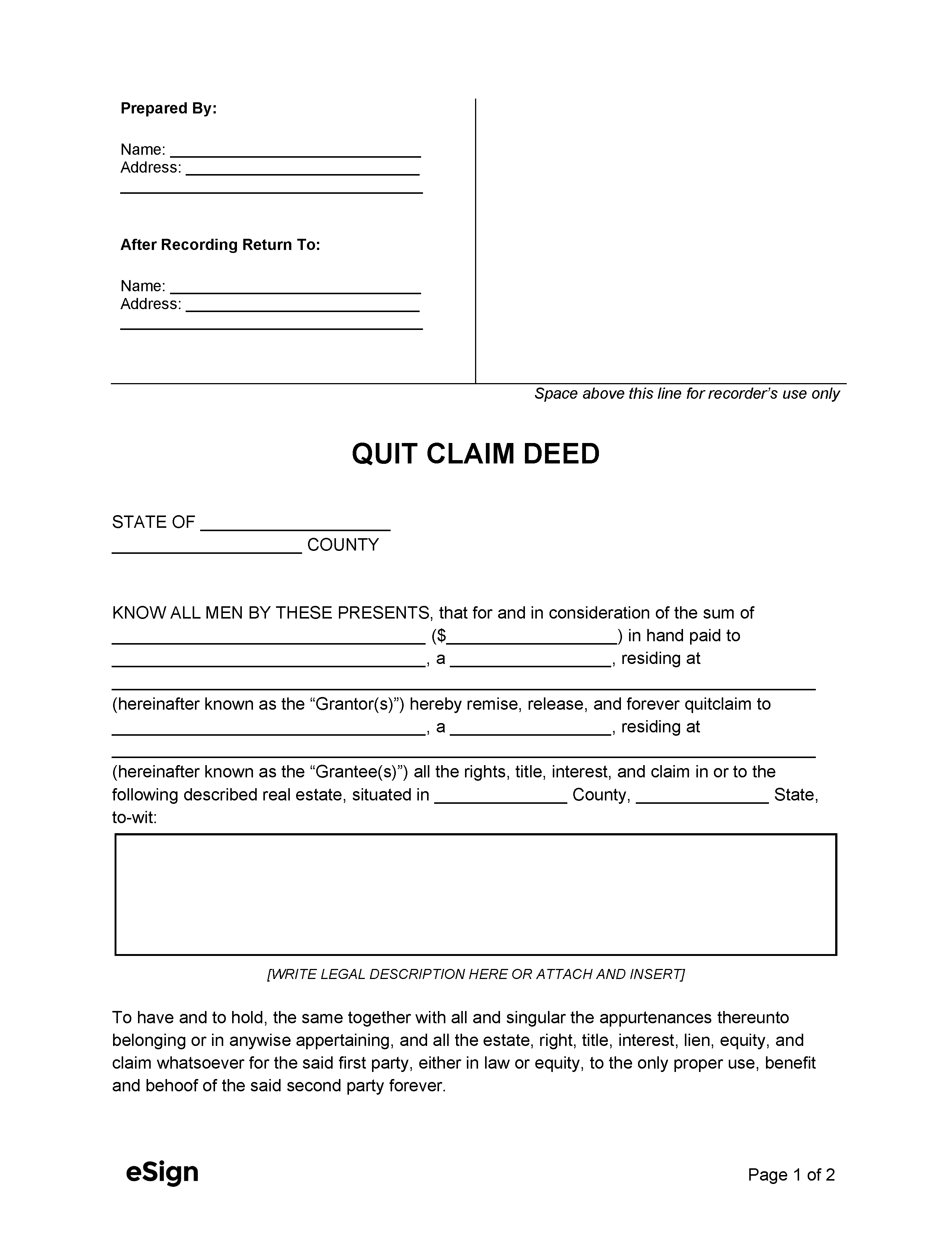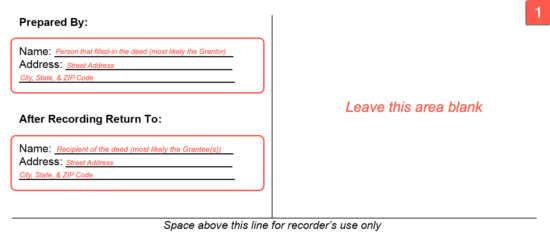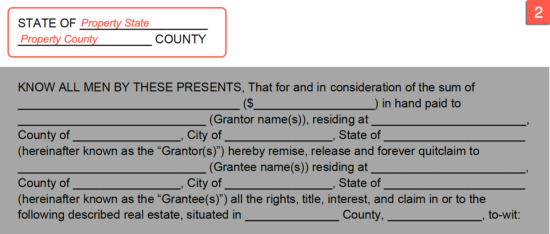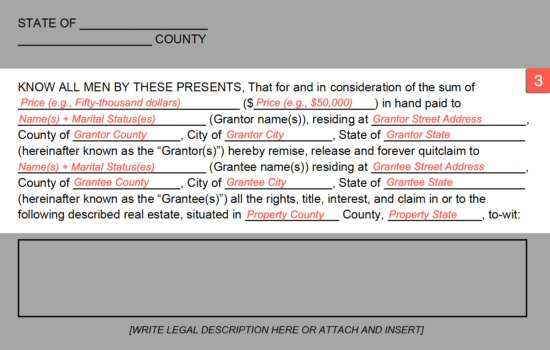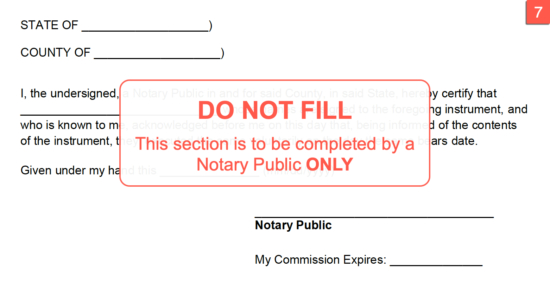A quit claim deed is a legal document used for transferring a property’s title from one person to another. The document prioritizes speed and simplicity but forfeits any guarantees regarding the quality of the title that other types of deeds convey.
- General warranty deed – Provides guarantees regarding the title for both the current owner and all previous owners.
- Special warranty deed – Similar to a general warranty deed except it only guarantees the property for the period of time the seller owned the property (i.e., does not guarantee the title for any previous owners).
By State
- Alabama
- Alaska
- Arizona
- Arkansas
- California
- Colorado
- Connecticut
- Delaware
- Florida
- Georgia
- Hawaii
- Idaho
- Illinois
- Indiana
- Iowa
- Kansas
- Kentucky
- Louisiana
- Maine
- Maryland
- Massachusetts
- Michigan
- Minnesota
- Mississippi
- Missouri
- Montana
- Nebraska
- Nevada
- New Hampshire
- New Jersey
- New Mexico
- New York
- North Carolina
- North Dakota
- Ohio
- Oklahoma
- Oregon
- Pennsylvania
- Rhode Island
- South Carolina
- South Dakota
- Tennessee
- Texas
- Utah
- Vermont
- Virginia
- Washington
- West Virginia
- Wisconsin
- Wyoming
Contents |
What is a Quit Claim Deed?
A quit claim deed is a document completed by a grantor (seller) to convey a property’s title to the grantee (buyer). Upon recording the document with the local county recorder, the owner effectively releases their interest in the property to the named grantee(s).
What differentiates quit claim deeds from other types is that the owner doesn’t provide any guarantees to the grantee that the title is free of liens, defects, or that the grantor is even the rightful owner. Because of the inherent risk involved, this type of deed is typically reserved for situations in which the parties know each other well, such as gifting property to children or removing a spouse from the title after a divorce.
What can it be used for?
A quit claim deed can be used for several property-related tasks, including the following:
- Clearing a title defect – Title defects (“clouds”) are anything that prevent a title from being conveyed from one person to another. They can come in the form of unknown easements, liens, mortgages, survey or boundary issues, misspellings, or missing information in the deed.
- Removing someone from the title – Often used in the event of a divorce where the the grantor intends on withdrawing their spouse’s name from the title.
- Transferring property – Since a quit claim deed relies heavily on both parties trusting one another (due to no guarantees being provided), they are especially useful for gifting property to family members or friends.
Sample
Download: PDF (Blank) | PDF (Sample Data)
Prepared By:
Name: [PREPARER NAME]
Address: [PREPARER ADDRESS]
After Recording Return To:
Name: [RECIPIENT NAME]
Address: [RECIPIENT ADDRESS]
Space above this line for recorder’s use only
QUIT CLAIM DEED
STATE OF [STATE NAME]
COUNTY OF [COUNTY]
Know all men by these presents, that for and in consideration of the sum of [AMOUNT (IN WORDS)] ($[AMOUNT (AS A NUMBER)]) in hand paid to
[GRANTOR NAME(S)], a [GRANTOR(S) MARITAL STATUS], residing at [GRANTOR(S) STREET ADDRESS] (hereinafter known as the “Grantor(s)”) hereby remise, release, and forever quitclaim to [GRANTEE NAME(S)], a [GRANTEE(S) MARITAL STATUS], residing at [GRANTEE(S) STREET ADDRESS] (hereinafter known as the “Grantee(s)”) all the rights, title, interest, and claim in or to the following described real estate, situated in [COUNTY NAME] County, [STATE NAME] State, to-wit:
[ENTER PROPERTY LEGAL DESCRIPTION (OR ATTACH AS SEPARATE PAGE)].
To have and to hold, the same together with all and singular the appurtenances thereunto belonging or in anywise appertaining, and all the estate, right, title, interest, lien, equity, and claim whatsoever for the said first party, either in law or equity, to the only proper use, benefit and behoof of the said second party forever.
Grantor Signature: _________________________
Grantor Name: [GRANTOR NAME]
Grantor Address: [GRANTOR ADDRESS]
Grantor Signature: _________________________
Grantor Name: [GRANTOR NAME]
Grantor Address: [GRANTOR ADDRESS]
Witness Signature: _________________________
Witness Name: [WITNESS NAME]
Witness Address: [WITNESS ADDRESS]
Witness Signature: _________________________
Witness Name: [WITNESS NAME]
Witness Address: [WITNESS ADDRESS]
STATE OF [STATE]
COUNTY OF [COUNTY]
I, the undersigned, a Notary Public in and for said County, in said State, hereby certify that [GRANTOR NAME(S)], whose name is signed to the foregoing instrument and who is known to me, acknowledged before me on this day that, being informed of the contents of the instrument, they executed the same voluntarily on the day the same bears date.
Given under my hand, this [MM/DD/YYYY]
_________________________
Notary Public
My Commission Expires: [MM/DD/YYYY]
How to Use
Quit claim deeds are the fastest and most efficient means of transferring real property. As long as the grantor and grantee know and trust one another and the title is free of defects, they’re just as effective at conveying property as a warranty or special warranty deed.
Step 1 – Obtain the Correct Form
Each state has highly specific requirements for how deeds need to be formatted. Because of this, using a deed customized to the state in which the property is located is essential. If the formatting is incorrect, the county recorder can reject the deed.
Step 2 – Input Information
Once obtained, the form can be completed by hand or online. The following information will be required in order to complete the deed:
- The names, marital statuses, and addresses of the grantor(s) and grantee(s)
- The amount ($) the property is being sold for. If the property is a gift, an amount is still required in order for the deed to be valid (between $1 – $10 is often sufficient).
- The state and county in which the property is located.
- The official legal description of the property. This can be found at the recorder of deeds in the county where the property is located.
Step 3 – Sign and Acknowledge
Check the signing requirements for the state in which the deed is being completed. Every state requires that the deed be notarized or that the signatures of the parties be witnessed by impartial (disinterested) individuals.
If witnesses are required, they should be disinterested, which is a term that refers to a witness that has no stake in the property being transferred. Furthermore, the witness should not be someone that is related to either party, whether by blood or marriage.
Step 4 – Record
Once the deed has been completed, signed, and acknowledged by the appropriate parties, the grantor will need to bring the form to the recorder’s office in the same county where the property is located. A fee will be required to file the document (for example, the Dallas, TX County Clerk has a fee of $26 for the first page, and $4 for any additional pages).
How to Fill Out a Quit Claim Deed
Download: PDF, Word (.docx), OpenDocument
Step 1 – “Prepared By” + “After Recording” Sections
Enter the name and address of the person that is completing the deed (this will most likely be the grantor, unless a representative is filling out the form in their stead). Beneath their name, enter their mailing address, including the city, state, and ZIP code.
For the “After Recording Return To” section, enter the name(s) and address of those that will be receiving the deed (presumably the grantee(s)).
Step 2 – State & County
Enter the state and county in which the property is located.
Step 3 – Grantor(s) & Grantee(s) Info
In this section, the following information will need to be entered:
- The amount that is being paid to the grantor(s) for the property. The first field should contain the written amount (e.g., one hundred thousand dollars) and the second the numerical amount ($100,000).
- The name(s) and marital status(es) of the grantor(s).
- If the grantor is just one person, it could be written as: “John Smith, a single individual.”
- If there are two (2) grantors, it could be written as: “Kevin Smith and Katy Smith, a married couple.”
- The address of the grantor(s). This includes the street address, county, city, and state.
- The name(s) and marital status(es) of the grantee(s).
- The address of the grantee(s).
- The county and state where the property is located.
Step 4 – Property Description
The legal description of the property can be found on the existing deed for the property. The deed can be found in the county clerk or recorder’s office.
Many offices have online records that can be searched without going to the clerk in person. If the property description is especially long, it can be entered on a separate page, which should be attached to the quit claim deed.
Note: The entity that manages a county’s deeds is usually the “county clerk” or “county recorder” but can go by several different names including “registrar of deeds,” “deeds registry,” “county register of deeds,” or “township clerk.”
Step 5 – Grantor Signature(s)
The grantor(s) will need to sign the form in compliance with the requirements in their state. Notarization is almost always required, with only a few states permitting the use of witnesses instead of notary acknowledgment. If the grantor(s) will be having their signatures notarized, they cannot sign until directed to do so by the notary public.
Note: There are no signature fields for the grantee(s). This is intentional, as the grantor is the only party that needs to sign in all 50 states.
Step 6 – Witness Signature(s)
If the grantor(s) will be signing the deed in the presence of one (1) or more witnesses, each witness will need to sign and print their name and provide their mailing address (including their city, state, and ZIP code).
Step 7 – Notarization
The notarization section is for a Notary Public to complete ONLY. At the time of notarization, the notary will complete all applicable fields, inscribe their signature, and add their official seal.
